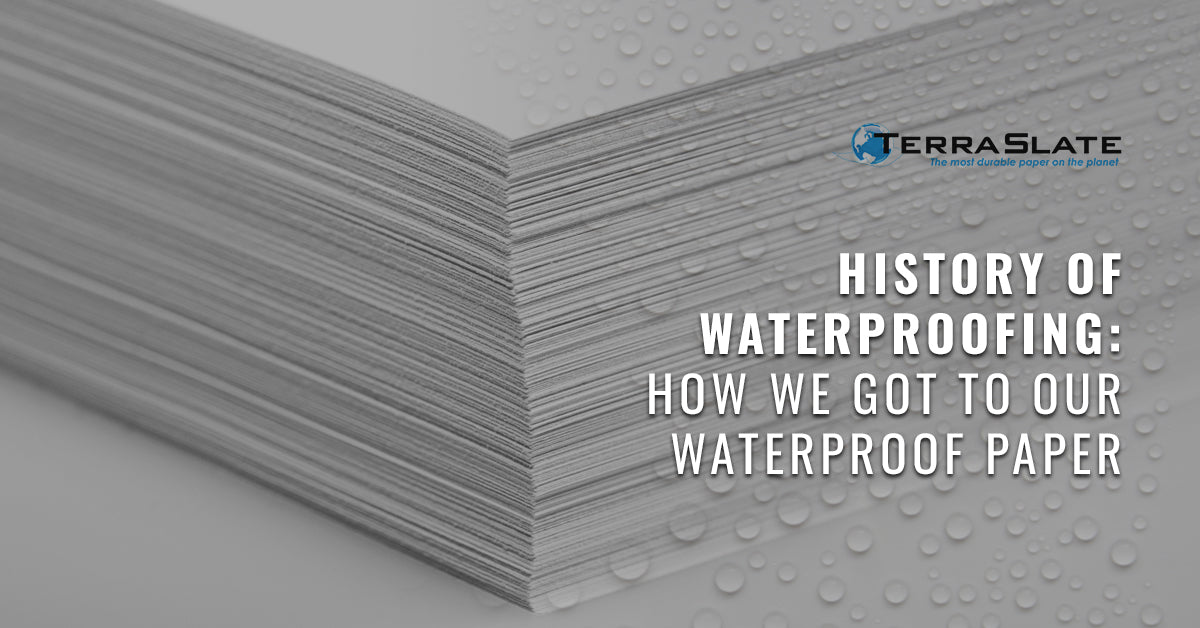
Water typically seems harmless enough, right? After all, we drink the stuff on a daily basis; we use it to wash ourselves, our clothes, and so many other things in our homes; and we rely on water to grow the sustenance that keeps us alive — and that’s just the tip of the metaphorical iceberg of water uses. Outside of hurricanes and flooding, water is rarely looked at as a damaging substance. And yet, without some basic protective measures, water can cause widespread damage to a vast list of different materials we use every day. Something many of us ignore is the value of things that are waterproof. From home exteriors, to pool linings, to waterproof paper, the technology to make things impervious to water is an integral part of our daily lives. Here’s how we got to where we are today:
Early Waterproofing Measures
Waterproofing has been a concern pretty much as long as humanity has been around. In part, the need for waterproofing can be traced to our need for water itself. For example, waterproofing techniques are what allowed people to start living further and further from a water source. When there were ways to collect water in vessels that didn’t leak, people could live further inland. Large leaves woven together created simple baskets and vessels, and a sap coating made the vessel water-tight. From there, the vessels could be used to water crops as well as collect food and water. It was one-way humanity managed to shift away from hunter-gatherer units and settle into stationary communities.
Exploration
Even as early as the Neolithic era — which was roughly 12,000 years ago and considered the end of the Stone Age — people had an itch to travel and to migrate. Granted, it wasn’t necessarily to see the wonders of the world as we do now. As communities grew, exploration became a necessary byproduct, and as humanity explored further people began making boats. While wood is buoyant, water will slowly degrade it without additional protection. However, necessity being the mother of invention led to the use of bitumen (a black goo like the binding ingredient used in asphalt) to coat and protect boats.
Preservation
The ancient Egyptians are arguably some of the best innovators when it comes to waterproofing techniques. Not only did they figure out a mummification process, they also managed to create waterproofing for buildings. When the Pyramids at Giza were finally opened in the present day, archeologists found that the interior spaces were incredibly well preserved — despite the nearby Nile River flooding every spring. The Egyptians managed to perfect a bitumen emulsion which they used to seal the walls and protect against water damage. Interestingly, we use similar technology today to seal the foundations and basements.
Self-Protection
Of course, buildings and tools weren’t the only things to get waterproofing attention. Fabrics received a fair amount of focus in order to provide protection against the elements. Early methods involved coating fabric in wax to create a waterproof barrier for everything from sails to umbrellas. As technology improved, different methods were used to create waterproof fabrics, including plastic coatings (like a rain slicker) and plastic fibers (like hiking pants).
Expanding Our Uses
Of course, plastic didn’t just help us improve waterproof clothing, it also opened up a wide array of options for other uses. Everything from party tents to billboards to waterproof paper has come from the combination of invention and ingenuity to give us the expanded uses that so many situations call for.
This is, of course, where TerraSlate joins up with waterproofing history. Before our waterproof paper, the options to make paper water-resistant or waterproof generally involved a great deal of expense and post-processing. Our waterproof paper is neither expensive nor complicated to use. It works with a standard laser printer; simply print as you would normal printer paper, no post-processing or special treatments necessary. This makes our offering easier to customize, simpler to use, and less expensive than lamination — the previous waterproofing option. Since the waterproofing is already a part of the paper, TerraSlate waterproof paper is also much more resilient. TerraSlate can also be cut, punched and folded and is still 100% waterproof.
Learn all about the benefits of TerraSlate paper and experience the ease for yourself. Shop TerraSlate’s range of waterproof paper, adhesives, posters, and more online!






